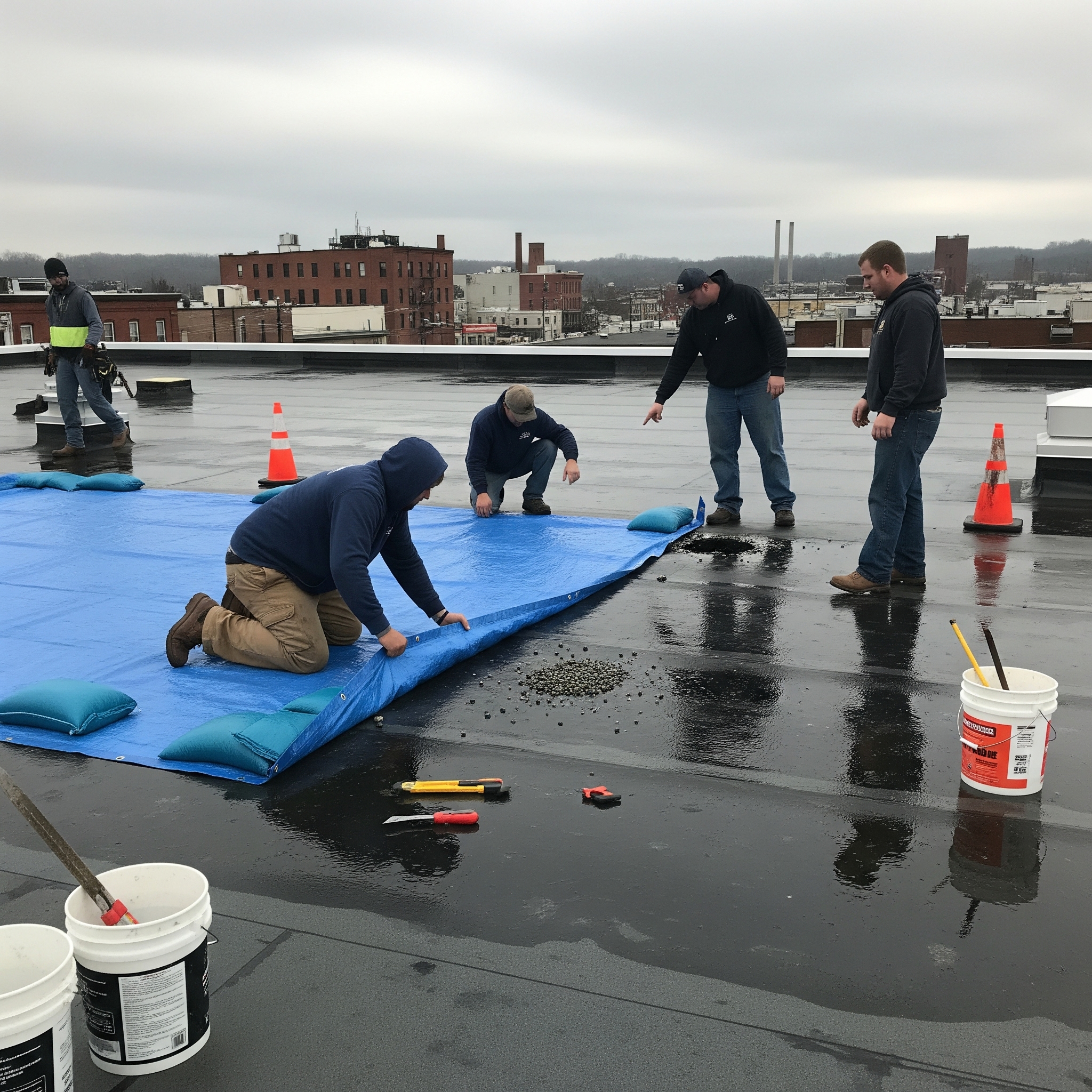Commercial roofing emergencies can strike at any time—during a storm, after heavy snowfall, or even on a calm day when long-neglected damage finally becomes critical. When water is pouring into your building or your flat roof begins to sag, the last thing you want to do is scramble for a solution.
That’s why every property owner or facility manager should have a solid emergency commercial roof repair plan in place—especially here in New Jersey, where extreme weather and aging buildings increase the risk of roof failures.
At Boundless Roofing & Chimney, we’ve handled hundreds of emergency commercial roofing calls. This guide explains what to include in your plan, how to minimize downtime, and when to call in professionals.
📞 Need urgent help? Call us now at 973-960-7921 or request a priority inspection.
Why You Need an Emergency Roof Repair Plan
When a commercial roofing emergency occurs, it can quickly cause:
-
Major water intrusion
-
Damage to electrical systems
-
Health hazards (mold, mildew)
-
Business interruption
-
Safety concerns for staff and customers
-
Long-term structural damage
A pre-established response plan saves you time, money, and liability by ensuring fast action and clear communication.
Common Commercial Roofing Emergencies in NJ
-
Severe leaks during or after heavy rain
-
Collapsed roofing due to snow load or structural failure
-
Wind or storm damage (e.g., lifted seams, torn membrane)
-
Ponding water compromising membrane integrity
-
Fire-related roof damage
-
Impact from fallen trees or rooftop equipment failure
Step-by-Step Emergency Roof Repair Planning
1. Identify the Risks Specific to Your Building
Start by listing potential threats to your property:
-
Is your building in a flood-prone area?
-
Does it have a flat roof prone to ponding water?
-
Are rooftop HVAC units old and heavy?
-
Do you receive high foot traffic on your roof?
Tailor your plan based on these known vulnerabilities.
2. Maintain a Current Roofing File
Keep a digital and printed record of:
-
Roof plans and original installation specs
-
Warranty documentation
-
Last inspection and repair reports
-
Photos of your roof’s condition (updated annually)
-
Emergency contact list (internal + contractors)
This file is essential for insurance claims, emergency assessments, and restoration timelines.
3. Establish a Response Chain of Command
Designate:
-
A primary decision-maker (facility manager, operations director)
-
A backup contact
-
Points of contact for building tenants or occupants
Everyone should know who to notify in an emergency and how to access roof areas safely.
4. Partner with a Trusted Commercial Roofing Contractor
This is critical. Trying to find help during a crisis slows down response time and can result in poor-quality work. Build a relationship with a local, licensed commercial roofing contractor like Boundless Roofing & Chimney.
We offer:
-
24/7 emergency service
-
Same-day tarp and leak containment
-
Flat roof repair expertise
-
Storm damage assessments
-
Temporary-to-permanent restoration plans
5. Know What to Do During a Roofing Emergency
When disaster strikes:
-
Evacuate affected interior areas if needed
-
Shut off electricity if water is near fixtures or equipment
-
Use buckets or plastic sheeting to control interior water damage
-
Photograph the damage for insurance and restoration documentation
-
Contact your roofing contractor immediately
6. Document the Damage Thoroughly
Photos, videos, and written observations are your best friends during an insurance claim. Capture:
-
Exterior damage (e.g., membrane tears, flashing failure)
-
Interior impact (e.g., ceiling stains, equipment damage)
-
Approximate timeline (when the leak or failure was first noticed)
7. Understand Insurance Coverage Before You Need It
Talk to your commercial property insurance provider before an emergency:
-
Confirm what roof-related damage is covered
-
Know your deductible and claim procedure
-
Ask if routine maintenance is required for coverage to apply
Some policies may deny coverage if you neglected inspections or postponed minor repairs.
Preventing Future Emergencies: Proactive Measures
-
Schedule biannual professional roof inspections (spring and fall)
-
Clean drains and gutters regularly
-
Reinforce flashing and seams as needed
-
Re-coat flat roofs every 5–10 years to improve waterproofing
-
Install protective walk pads to reduce membrane wear
Why Choose Boundless Roofing & Chimney
We’re not just roofers—we’re partners in protecting your commercial investment. Based in New Jersey, our team is equipped to respond fast, repair smart, and restore your roof with minimal disruption to your business.
Fully licensed & insured
Emergency repair experts for flat, low-slope, and metal roofs
Leak detection, structural assessments, and restoration
Maintenance plans to prevent future emergencies
📞 Call 973-960-7921 today or
📩 Schedule your emergency roof consultation
Final Thoughts
Roofing emergencies are inevitable—but property damage and downtime don’t have to be. With a proper emergency commercial roof repair plan, you’ll be prepared to act quickly and protect your building, business, and reputation.
Don’t wait for the next storm. Build your plan today with the help of Boundless Roofing & Chimney—New Jersey’s trusted partner in commercial roofing protection.

